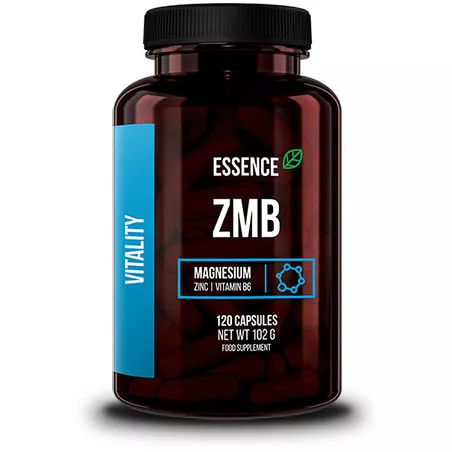- Out of stock





ZMB is an advanced product based on three active ingredients. The product in the convenient form of capsules guarantees the convenience of supplementation.
Essence ZMB. Dietary supplements in the form of capsules containing magnesium, zinc and vitamin B6.
Here is our next proposal that will help you balance your diet in terms of vitamin B6, which is important for the body, and micronutrients: magnesium and zinc. ZMB is an advanced product based on three active ingredients. The product is in the convenient form of capsules guarantees the convenience of supplementation.
Magnesium is an essential mineral for a wide variety of physiological functions and biochemical responses. It is primarily an intracellular cation and is required for the operation of over three hundred enzymes, most of which are involved in brain function. For example, magnesium ions play a fundamental role in the electrical conduction of nerves by regulating the flow of calcium ions through neuronal calcium channels. In addition, magnesium participates in all reactions related to anabolism and ATP catabolism in energy metabolism (1).
Properties of magnesium:
- contributes to the reduction of tiredness and fatigue and to maintaining proper energy metabolism;
- helps in the proper functioning of the nervous system and muscles;
- supports the maintenance of electrolyte balance and proper psychological functions;
- helps maintain healthy bones and teeth;
- plays a role in the process of cell division and supports the proper synthesis of proteins (2).
Zinc is an essential mineral that is involved in various biochemical processes related to brain growth and function (1). It plays a role in maintaining epithelial and tissue integrity by promoting cell growth and inhibiting apoptosis. It is also important as an antioxidant that protects cells from free radical damage (3). Zinc is considered an essential mineral because it is necessary for the production of hundreds of enzymes throughout the body. It acts as a cofactor in enzymatic reactions involved in DNA expression, membrane stabilization, vitamin A metabolism, and in the taste and olfactory systems (4).
Properties of zinc:
- helps to maintain the correct: cognitive functions, acid-base balance and carbohydrate metabolism;
- contributes to the maintenance of the proper metabolism of macronutrients, fatty acid metabolism and vitamin A metabolism;
- supports the maintenance of proper fertility and proper reproductive functions as well as an adequate level of testosterone in the blood;
- takes part in the process of cell division, helps in the proper synthesis of proteins and DNA;
- helps to maintain healthy hair, nails and skin and protects cells against oxidative stress;
- supports the proper functioning of the immune system (2).
Our body uses vitamin B6 in numerous enzymatic reactions, including the production of neurotransmitters, amino acid metabolism, glucose metabolism, lipid metabolism, haemoglobin synthesis and function, and gene expression (5). Vitamin B6 is an enzymatic cofactor required for over 140 biochemical reactions. Most of these reactions are related to the biosynthesis and degradation of amino acids but are also involved in other processes, including sugar and fatty acid metabolism (6).
Properties of vitamin B6:
- contributes to the maintenance of proper protein and glycogen metabolism, as well as to the maintenance of proper energy metabolism and;
- helps in the proper functioning of the immune system and the nervous system;
- helps to maintain proper psychological functions and proper production of red blood cells;
- contributes to the reduction of tiredness and fatigue, as well as to the regulation of hormonal activity (2).
Literature:
Dickerman B., Liu J., Do the Micronutrients Zinc and Magnesium Play a Role in Adult Depression? Topics in Clinical Nutrition, 2011, Jul-Sep; 26 (3): 257-267.
Commission Regulation (EU) No 432/2012 of 16 May 2012 established a list of permitted health claims made on foods, other than those referring to the reduction of disease risk and to children's development and health.
Berger A., What does zinc do? The BMJ, 2002, Nov 9; 325 (7372): 1062.
Agnew U. M., Slesinger T. L., Zinc Toxicity. In: StatPearls [Internet]. Treasure Island (FL): StatPearls Publishing; 2022 Jan-. Available from: https://www.ncbi.nlm.nih.gov/books/NBK554548/
Hemminger A., Wills B. K., Vitamin B6 Toxicity. In: StatPearls [Internet]. Treasure Island (FL): StatPearls Publishing; 2022 Jan-. Available from: https://www.ncbi.nlm.nih.gov/books/NBK554500/
Hellmann H., Mooney S., Vitamin B6: a molecule for human health? Molecules, 2010, Jan 20; 15 (1): 442-59.
| Porcja: | 2 kaps. |
| Ilość porcji w opakowaniu: | 60 |
| Opakowanie: | 120 kaps. |
| Mass net: | 102.00 g |
| Wartość odżywcza / Informacja żywieniowa | ||
| na 2 kaps. | % RWS* | |
| Magnez | 375 mg | 100% |
| Cynk | 15 mg | 150% |
| Witamina B6 | 4 mg | 286% |